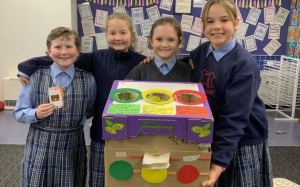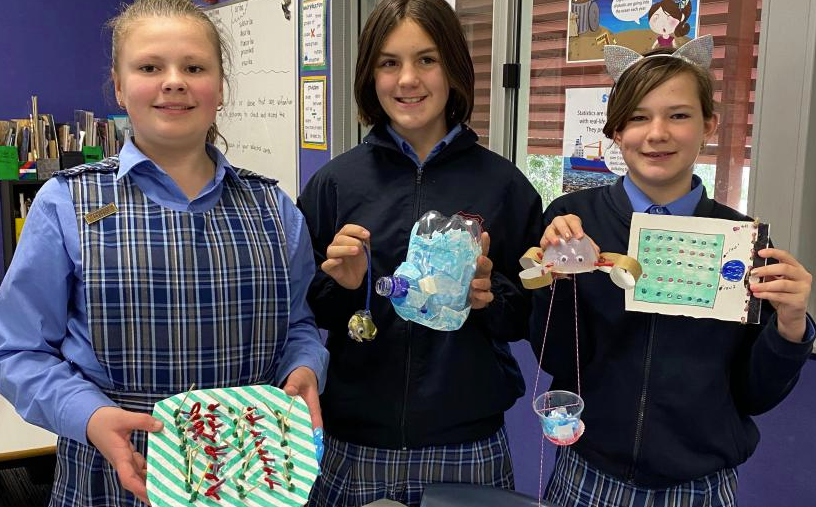EWB Australia teams up with organisations and industry determined to expose more girls and young women to STEM pathways and careers in the STEM Design Challenge.
It’s a massive conundrum for country Australia – how to water crops in times of drought.
Year six students in Parkes, New South Wales, brainstormed possible solutions, including this idea from ‘Team Luna Drone’ (pictured).
“Our sprinkler system comes with an app and a supervising drone. The drone’s name is Luna, which has a little iPad to help view the crop, and it has a water tank that we can screw in. And if the water tank runs out of water, the drone can deliver water to the paddock from dam water or river water.”
The STEM Design Challenge explores solutions for local communities
It’s part of the STEM Design Challenge, a collaboration between UTS Women in Engineering and IT, Tech Girls Movement Foundation, and Engineers Without Borders Australia, to reach schools in regional and remote New South Wales.
The program helps students to design solutions for problems specific to their local communities with the help of academic and professional mentors.
“We know that there are many talented girls in regional and remote communities who cannot imagine their future in STEM simply because they don’t have role models or information about the opportunities.
We have collaborated with Tech Girls Movement Foundation and Engineers Without Borders to deliver this challenge so we can reach more students and provide regional schools with more connections to further opportunities in STEM,” said Arti Agrawal, Director of UTS Women in Engineering and IT.
Five regional schools took part, including Central West Leadership Academy, Blayney High School, Parkes Public School, Bowen Public school in Orange, and Wilcannia Central School.

Students in Parkes, New South Wales, brainstormed possible solutions that address the challenges of drought in their local region.
Finding new ways to engage in the time of COVID-19
The STEM Design Challenge is an example of finding new ways to engage school students during the COVID-19 pandemic. Via virtual classrooms, students can design, create and build solutions to problems in their communities using technology, engineering, science and maths.
“It was great to see the students focusing on addressing problems within their regional communities and the diverse range of ideas presented to address these issues.”
– Mark Lindenmayer, Dell Technologies
Founder and CEO of the Tech Girls Movement Foundation, Dr Jenine Beekhuyzen, says the students bring interesting and useful perspectives to issues they care about.
“Including regional and remote students in STEM education is necessary as they have different community challenges to solve than students in the big cities.”
Alison Stoakley, Engineering Education Manager at Engineers Without Borders Australia, says collaborating with UTS WiEIT and Tech Girls Movement Foundation is a great opportunity to combine the groups’ energy and networks towards a larger aim.
“We think it’s really important that all young people have the opportunity to see what’s possible through engaging with STEM. Initiatives like the STEM Design Challenge, alongside access to stories shared by inspiring, relatable role models, can make STEM pathways more visible, more relevant, and more exciting for everyone.”
Support from industry
The STEM Design Challenge also has strong industry support. Mark Lindenmayer has worked for years as a leader within the IT industry, and has witnessed first-hand the challenges it faces in attracting a diverse range of candidates into technical roles.
“What I have come to recognise is that our industry must be proactive in driving workforce diversity and this starts at the ground-level by actively working with young people across our society to build an interest in STEM subjects and encouraging them to pursue careers in the IT industry.”
Mark Lindenmayer is the Director of Enterprise Professional Services at Dell Technologies, and also participated as a mentor for the STEM Design Challenge.
“I hope that my involvement increased the student awareness of the potential that technology has to address real-world problems. My approach during this initiative was to provide an industry perspective into the design process and encourage the students to take a human-centric design approach, with a focus on using technology to optimise their designs.
“It was great to see the students focusing on addressing problems within their regional communities and the diverse range of ideas presented to address these issues.”
Be inspired by women in STEM sharing #MySTEMstory – who grew up in rural New South Wales and are inspiring rural girls to dream big.
The article was first published by UTS.


